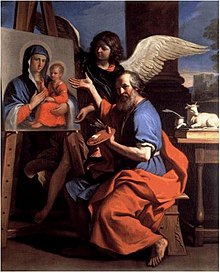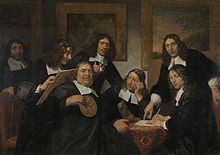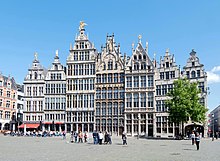Guild of Luke

Luke guilds were the guild-like brotherhoods z. B. by painters , carvers and book printers , who were educated especially in Italy, on the Lower Rhine and in the Netherlands since the 15th century . They were named after the evangelist Luke , the patron saint of painters .
membership
In some cities, a large number of artistic professions were represented in this guild (e.g. in Antwerp ) or it was just the painters' association with strictly regulated access, while carvers and glaziers, masons or printers founded other guilds under the protection of other patrons (e.g. in Brussels ). To join the guild, it was often necessary to acquire citizenship of the city and sometimes land. When enrolling as a master, which was a prerequisite for access to higher political and economic guild offices, marriage was also a prerequisite.
The membership of the painters in the guild offered the artists more security in a time of economic volatility. It guaranteed the promotion of local artists by excluding competition and offered the opportunity to open a workshop with apprentices who were not allowed to sign their own works, but whose paintings then automatically passed into the possession of the teacher. Another advantage was the right of the guild member to sell his works on the public art market . In Antwerp and other cities in the south of the Netherlands, the guild maintained a quality control over its members by marking the finished works of art with a stamping iron. These quality assurance measures promised buyers across Europe the same quality of art production in Antwerp.
In addition, the guild offered a certain social security, for example in emergencies or illness or in the guardianship of orphans and widows of deceased members. Religious matters were sometimes entrusted to the guild in the event of the member's death and burial and the necessary afterlife. The altar of the Guild of Luke in Antwerp was in the Church of St. Jacob, in which some of the painters ( Hendrik van Wueluwe or Peter Paul Rubens ) were also buried. The fraternity of guild members based at the guild churches or chapels was often the outward expression of togetherness and a strong instrument of social and political influence. From 1473 the Ulm school had its own winged altar in the church of St. Michael zu den Wengen .
Important Guilds of St. Luke
Antwerp

Members of the Antwerp Guild were (with year of admission):
- Pieter Coecke van Aelst (1527)
- Cornelis Floris II (1538)
- Pieter Bruegel the Elder (1551)
- Hans Bol (1574)
- Hendrick van Steenwyck the Elder (1577)
- Gillis Congnet (1585)
- Peter Paul Rubens (1598)
- Frans Snyders (1602)
- Jacob van Hulsdonck (1608)
- Georg Geldorp (1610)
- Johannes van Mildert (1610)
- Peeter Snayers (1612)
- Alexander Keirincx (1619)
- Adriaen van Utrecht (1625)
- Pieter Bruegel the Younger (1625)
- Theodore Rombouts
- Erasmus Quellinus II (1633/1634)
- Hieronymus Galle (1636)
- Jan Meyssens (1640)
- Gonzales Coques (1640/1641)
- Jan van Kessel the Elder (1645)
- Jan Pauwel Gillemans Père (1647/1648)
- Nicolaes Millich (1657)
- Lode van der Linden (1908)
Bruges
- Luís Alimbrot (1432)
- Hans Memling (1467)
- Gerard David (1484; 1501 chairman)
Delft
- Jacob Woutersz Vosmaer (1613)
- Hendrick Cornelisz. van Vliet (1632)
- Nicolaes Vosmaer (1645)
- Daniel Vosmaer (1650)
- Carel Fabritius (1652)
- Jan Vermeer (1653)
- Pieter de Hooch (1655)
Haarlem

The existence of a painters' guild in Haarlem was first established in 1496, at that time still under the patronage of St. Eligius , proven. The oldest surviving statutes date from 1514.
- Sara van Baalbergen (1631 first female member)
- Jan de Bray
- Frans Hals
- Cornelis van Haarlem
- Jacob van Campen
- Judith Leyster
- Karel van Mander (1548–1606)
- Adriaen van Ostade
- Jacob van Ruisdael
Mechelen
- Pieter Bruegel the Elder (before 1563)
- Frans Verbeeck (1563)
Wurzburg
- Hans Ulrich Bühler (around 1590-1640)
- Peter Dell the Elder (around 1490-1552)
- Hans Gottwald , student of Tilman Riemenschneider
- Tilman Riemenschneider (around 1460-1531)
- Martin Seger (illustrator) (* around 1510 / 1515–1580), illustrator of Lorenz Fries ' episcopal chronicle and court painter to the prince-bishop
- Wilhelm Ziegler (painter) (also Wilhalm Ziegler ; around 1480 – after 1544), German painter and cartographer
See also
- Académie de Saint-Luc (Paris, guild founded in 1391)
- Accademia di San Luca (Venice, founded in 1593)
- Institut Saint-Luc (Brussels, School of Applied Arts, founded in 1904)
literature
- Werner Jacobsen: The painters of Florence at the beginning of the Renaissance. Deutscher Kunstverlag, Berlin / Munich 2001, ISBN 978-3422062856 .
Web links
Individual evidence
- ↑ Bertil Waldén: Nicolaes Millich and Hans Krets: Studier i den Karolinska baroque sculptural construction . Saxon & Lindströms förlag, Stockholm 1942 (Swedish, limited preview in Google book search).
- ^ CJ Gonnet: Sint Lucas Gilde te Haarlem in 1631 , 1877, North Holland Archives, Haarlem. (Dutch)
- ^ Bühler, Johann (Hans) Ulrich, also Bieler, Büchler, Büeler . In: Large Bavarian Biographical Encyclopedia. P. 255.
- ^ Museum for Franconia: Between Riemenschneider and Reformation: Peter Dell the Elder .
- ^ A "star" of the late Gothic from Lohr . In: Main-Echo. 5th September 2018.
- ↑ Martin Granzin: Where did Riemenschneider come from? In: The time. No. 34, 1957.
- ↑ Stefan Kummer : Architecture and fine arts from the beginnings of the Renaissance to the end of the Baroque. In: Ulrich Wagner (Hrsg.): History of the city of Würzburg. 4 volumes; Volume 2: From the Peasants' War in 1525 to the transition to the Kingdom of Bavaria in 1814. Theiss, Stuttgart 2004, ISBN 3-8062-1477-8 , pp. 576–678 and 942–952, here: pp. 582 and 586 f.
- ^ SIKART lexicon on art in Switzerland: Ziegler, Wilhelm (painter) .
